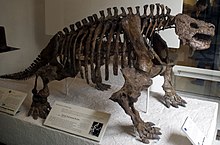
Mesosaurs were a group of small aquatic reptiles that lived during the early Permian period (Cisuralian), roughly 299 to 270 million years ago. Mesosaurs were the first known aquatic reptiles, having apparently returned to an aquatic lifestyle from more terrestrial ancestors. It is uncertain which and how many terrestrial traits these ancestors displayed; recent research cannot establish with confidence if the first amniotes were fully terrestrial, or only amphibious. Most authors consider mesosaurs to have been aquatic, although adult animals may have been amphibious, rather than completely aquatic, as indicated by their moderate skeletal adaptations to a semiaquatic lifestyle. Similarly, their affinities are uncertain; they may have been among the most basal sauropsids or among the most basal parareptiles.

Bradysaurus was a large, early and common pareiasaur. They possessed a covering of armoured scutes, likely serving as defense against their main predators, the gorgonopsians.

Pareiasaurs are an extinct clade of large, herbivorous parareptiles. Members of the group were armoured with osteoderms which covered large areas of the body. They first appeared in southern Pangea during the Middle Permian, before becoming globally distributed during the Late Permian. Pareiasaurs were the largest reptiles of the Permian, reaching sizes equivalent to those of contemporary therapsids. Pareiasaurs became extinct at the end of the Permian during the Permian-Triassic extinction event.
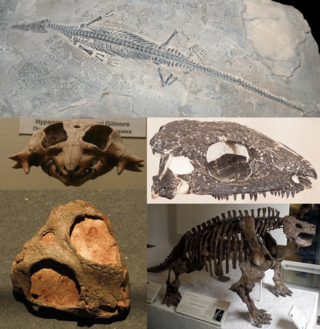
Parareptilia ("near-reptiles") is a subclass or clade of basal sauropsids/reptiles, typically considered the sister taxon to Eureptilia. Parareptiles first arose near the end of the Carboniferous period and achieved their highest diversity during the Permian period. Several ecological innovations were first accomplished by parareptiles among reptiles. These include the first reptiles to return to marine ecosystems (mesosaurs), the first bipedal reptiles, the first reptiles with advanced hearing systems, and the first large herbivorous reptiles. The only parareptiles to survive into the Triassic period were the procolophonoids, a group of small generalists, omnivores, and herbivores. The largest family of procolophonoids, the procolophonids, rediversified in the Triassic, but subsequently declined and became extinct by the end of the period.

The Procolophonia are a suborder of herbivorous reptiles that lived from the Middle Permian till the end of the Triassic period. They were originally included as a suborder of the Cotylosauria but are now considered a clade of Parareptilia. They are closely related to other generally lizard-like Permian reptiles such as the Millerettidae, Bolosauridae, Acleistorhinidae, and Lanthanosuchidae, all of which are included under the Anapsida or "Parareptiles".

Nyctiphruretus is an extinct genus of nyctiphruretid parareptile known from the Guadalupian series of European Russia.
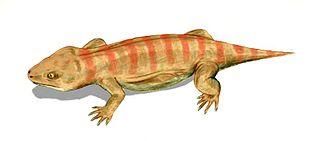
Procolophon is a genus of lizard-like procolophonid parareptiles that first appeared in the Early Triassic (Induan) of South Africa, Brazil, and Antarctica. It persisted through the Permian–Triassic extinction event, but went extinct in the beginning of the Early Middle Triassic. The type species is P. trigoniceps.

Macroleter is an extinct genus of nycteroleterid parareptile which existed in Oklahoma and Russia during the upper Permian period. It was a quite generalized primitive reptile, in many ways resembling their amphibian ancestors. It was first named by paleontologists Tverdochlebova and Ivachnenko in 1984. According to classification by Michel Laurin and Robert R. Reisz, the genus is a parareptile, belonging to the same branch as Millerettidae, Procolophonidae and other generalized anapsid reptiles. The type species is Macroleter poezicus from Upper Permian of Russia.

Nycteroleter is an extinct genus of nycteroleterid parareptile known from the Middle Permian of European Russia. Fossils were first found in the Mezen River, near to Arkhangelsk. Within the Nycteroleteridae, it is considered most closely related to Emeroleter. However, its legs were shorter than those of Emeroleter and its skull was flatter. Nycteroleter was insectivorous, and may have been nocturnal. It was a small animal, less than a metre long.
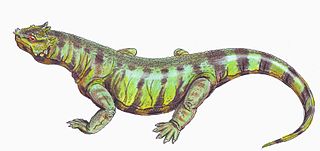
Rhipaeosaurus is an extinct genus of nycteroleterid parareptile known from an articulated skeleton from the mid Middle Permian of European Russia. It contained a single species, Rhipaeosaurus tricuspidens. A bayesian analysis suggests that it is more closely related to pareiasaurs than to the other nycteroleterids, due to skull and tooth features. For this reason, "Nycteroleteridae" may be a grade rather than a clade, unless redefined to exclude Rhipaeosaurus.
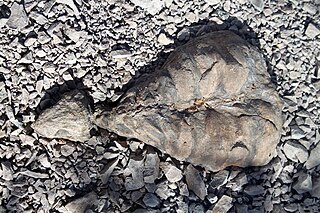
Eunotosaurus is an extinct genus of amniote, possibly a close relative of turtles. Eunotosaurus lived in the late Middle Permian and fossils can be found in the Karoo Supergroup of South Africa. Eunotosaurus resided in the swamps of southern Africa. Its ribs were wide and flat, forming broad plates similar to a primitive turtle shell, and the vertebrae were nearly identical to those of some turtles. Accordingly, it is often considered as a possible transitional fossil between turtles and their prehistoric ancestors. However, it is possible that these turtle-like features evolved independently of the same features in turtles, since other anatomical studies and phylogenetic analyses suggest that Eunotosaurus may instead have been a parareptile, an early-diverging neodiapsid unrelated to turtles, or a synapsid.

Acleistorhinus (ah-kles-toe-RYE-nuss) is an extinct genus of parareptile known from the Early Permian of Oklahoma. It is notable for being the earliest known anapsid reptile yet discovered. The morphology of the lower temporal fenestra of the skull of Acleistorhinus bears a superficial resemblance to that seen in early synapsids, a result of convergent evolution. Only a single species, A. pteroticus, is known, and it is classified in the Family Acleistorhinidae, along with Colobomycter.

Procolophonoidea is an extinct superfamily of procolophonian parareptiles. Members were characteristically small, stocky, and lizard-like in appearance. Fossils have been found worldwide from many continents including Antarctica. The first members appeared during the Late Permian in the Karoo Basin of South Africa.

Microleter is an extinct genus of basal procolophonomorph parareptiles which lived in Oklahoma during the Early Permian period. The type and only known species is Microleter mckinzieorum. Microleter is one of several parareptile taxa described from the Richards Spur fissure fills, and can be characterized from its high tooth count, lacrimal/narial contact, short postfrontal, and slit-like temporal emargination edged by the postorbital, jugal, squamosal, and quadratojugal. Contrary to Australothyris, which had a similar phylogenetic position as a basal procolophonomorph, Microleter suggests that early parareptile evolution occurred in Laurasia and that multiple lineages developed openings or emarginations in the temporal region.

Ankyramorpha is an extinct clade of procolophonomorph parareptiles which lived between the early Cisuralian epoch and the latest Triassic period of Africa, Antarctica, Asia, Australia, Europe, North America and South America.

Lanthanosuchoidea is an extinct superfamily of ankyramorph parareptiles from the middle Pennsylvanian to the middle Guadalupian epoch of Europe, North America and Asia. It was named by the Russian paleontologist Ivachnenko in 1980, and it contains two families Acleistorhinidae and Lanthanosuchidae.
Nyctiphruretidae is an extinct family of hallucicranian parareptiles known from the late Early to the late Middle Permian of European Russia and south-central United States.

Nycteroleteridae is a family of procolophonian parareptilians from the Middle to Late Permian of Russia and North America. They are sometimes classified as a sister group to pareiasaurids. The group includes the genera Macroleter, Bashkyroleter, "Bashkyroleter" mesensis, Nycteroleter, Emeroleter, and probably Rhipaeosaurus. They were carnivorous, and occasionally ate insects. The group was most common in European Russia, with only a few fossils in North America. One fossil has also been found in Africa, but this is the only one from Gondwana.
Barasaurus is an extinct genus of owenettid procolophonoid parareptile known from the Late Permian and Early Triassic of Madagascar. It contains a single species, Barasaurus besairiei.
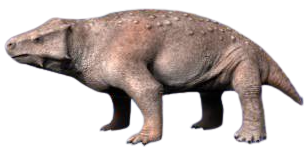
Parasaurus is a genus of pareiasaur known from fossils collected in the Kupferschiefer in Germany, dating to the Late Permian (Wuchiapingian). The type species, Parasaurus geinitzi, described by Hermann von Meyer in 1857, was the first pareiasaur ever described. The seven known specimens were redescribed in 2008.



